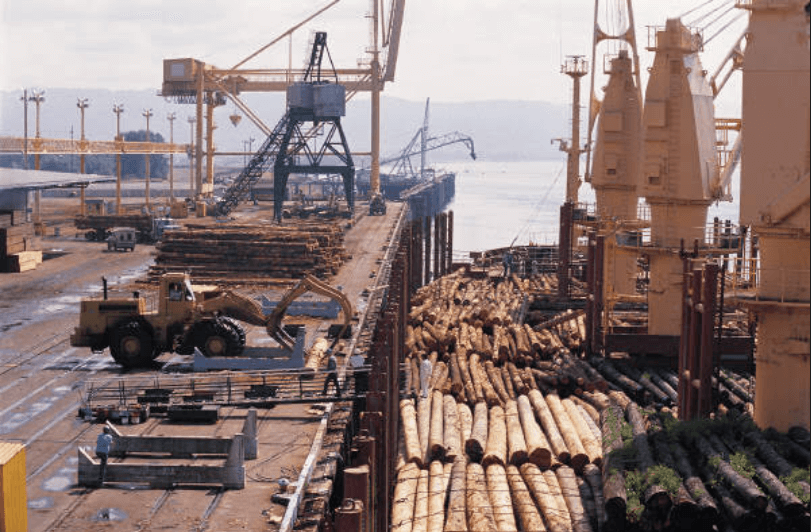Hardwood log availability is under considerable pressure in Europe due to declining forest productivity due to climatic disturbances and rising log exports to China.
And a wide range of new policy and regulatory measures doesn’t help.
Prices for European hardwoods have remained relatively firm, particularly for oak, even as consumption is declining in the face of the economic slowdown.
These are key messages from the latest annual report of the European Organisation of the Sawmill Industry (EOS) published in June.
Member countries are Austria, Belgium, Denmark, Finland, France, Germany, Latvia, Norway, Romania, Sweden, and Switzerland.
The report includes sawn wood production and consumption data for the 11 EOS member countries alongside the UK and Italy as major consumers.
The EOS estimate total sawn wood production in the 13 countries to have been 92.3 million cub m in 2022, a 4% decline compared to the previous year.
Softwood Production
Sawn softwood production in the 13 countries fell 4% to 86.6 million cub m in 2022 but was still at the second-highest annual level before the 2008 financial crisis.
Sawn softwood production in these countries rose almost continuously between 2013 and 2021.
Sawn hardwood production in the 13 EOS countries was down 6% to 5.7 million cub metres 2022.
In contrast to softwoods, hardwood lumber production in these countries slid between 2015 and 2019 and only picked up briefly in 2021 when demand increased rapidly during the ‘Covid home improvement boom’.
Sawn hardwood production last year was only marginally above 2020 and was at the second-lowest level since 2013.
In 2023, EOS forecast that total sawn wood production in the 13 countries will decline a further 2% to 90.1 million cub m with sawn softwood production down 2% to 84.6 million cub m and sawn hardwood production falling 4% to 5.5 million cub metres.
Hardwood Production
EOS observes that Europe’s three largest lumber-producing countries, Romania, France and Germany, reported significant declines in 2022.
This was driven more by constraints to log supply than by falling consumption.
However, in the second half of last year, slowing demand was a major market feature, particularly in Germany and Romania.
EOS suggests that “national and European legislation is curbing the availability of raw materials while many hardwood species remain underutilised”.
The quality of some species, such as beech, is also declining.
This is posing a new set of challenges for many mills, particularly but not only in Germany.
The geopolitical situation negatively affects hardwood companies that rely on foreign trade with “long-distance exports influenced by high freight rates, pandemic-related tension in China and rocketing fuel prices”.
According to EOS, another challenge on the supply side is that a significant proportion of logs – particularly oak, by far the most popular European hardwood species- are being exported to China and thereby diverting from European mills.
China’s import data shows imports of oak logs from European countries (excluding Russia) of 981,000 cub metres in 2022, up 20% from 818,000 cub metres the previous year.
Total sawn wood consumption
Total sawn wood consumption in the 13 EOS countries is estimated to have declined 13% to 63.8 million cub metres and is forecast to fall another 2% this year.
Sawn softwood consumption fell 14% to 58.7 million cub metres in 2022 and will also lose 2% this year.
Sawn hardwood consumption fell 10% to 5.2 million cub m in 2022 and will drop 1% in 2023.
The decline in European-sawn hardwood consumption is due to shortages in domestic hardwood supply, particularly for the most favoured species of oak, which kept prices high at a time when wider geopolitical and economic trends were undermining demand.
Impact of the Ukraine War
The war in Ukraine has had a particularly detrimental effect on buyer sentiment, contributing to the sharp rise in energy prices and wider inflation which led to a big increase in interest rates and a sharp rise in borrowing costs in European countries.
While significant, the direct effect of the war on the supply of hardwood lumber in Europe has not been as severe as in the softwood sector.
According to EOS, Russian imports comprise just 0.5% of EU-sawn hardwood consumption.
It also confirmed that Ukrainian imports comprise 2.5-3% of European consumption, with the three countries’ market share about 3-3.5%.
Importantly, Ukrainian exports of hardwood lumber are overwhelmingly valuable sawn oak products.






